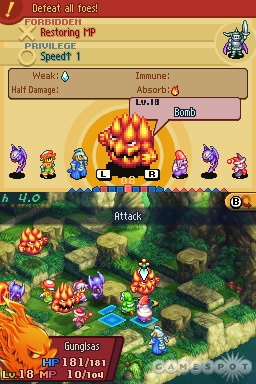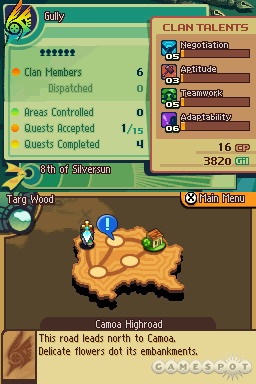Final Fantasy Tactics A2: Grimoire of the Rift is the Nintendo DS sequel to the Game Boy Advance's Final Fantasy Tactics Advance. Grimoire is a strategy role-playing game that has inherited many of the franchise's characteristics, including the classic grid-based movement system and a bevy of new jobs, but it also boasts full stylus controls and a dual-screen presentation. However, some may feel bogged down by its frustrating law system and steep learning curve.
Grimoire weaves the tale of Luso Clemens, a young boy who opens an ancient text that magically transports him to the world of Ivalice, where he immediately joins a clan that is determined to help him find a way home. The generic plot is advanced by completing quests, of which there are a formidable 400, ranging from simple fetch quests to missions that unlock classes or advance the story. All quests are picked up at the local pub for a small finder's fee and most culminate in a battle, and there are no random battles to beef up your team's experience coffer, although there is the occasional mugging or treasure opportunity presented on the world map.

Battles in Grimoire use a colorful 2D map with varied terrain that affects your unit's grid-based movement area. The game retains the franchise's turn-based battle system and displays the turn order and character-status effects on the top screen while target information is aligned at the bottom. You win the battle by completing the quest's objective, which is usually to eliminate a target. Although the 2D map understandably limits you from spinning the battlefield for closer inspection, this restriction gets frustrating because characters who are bunched up together often block other tiles from view, which makes it likelier that you'll select the wrong tile if you're using the cumbersome stylus controls. It's just easier to navigate through menus or traverse the battlefield via standard directional buttons. The lack of a zoom option is another irritation.
To put a spin on the standard battling, Square Enix once again included judges, those imposing figures from Tactics Advance who pulled you from battle and threw you in jail each time you broke a law, or battle rule. Grimoire's judges are less harsh and now reward you for following the law with a clan privilege, like a slight stat increase, that lasts the rest of the battle. Many of these rules are simple and ban the use of a specific ability, but some, like rules against distance attacks, can cost you a quest when you absolutely must follow the law to complete it. For example, accidentally knocking back an opponent while operating under a "no distance attacking" rule qualifies as breaking the law because somehow this maneuver counts as a distance attack, yet you have no control over this action. However, in most cases breaking the law results in imprisonment for your fallen allies, preventing you from raising them, and also costs you any bonus goods you might receive for completing the quest while following the law.
Team members who participate in battles are awarded experience points, but even benched members gain ability points needed to master abilities that are imbued in equipment. This feature keeps the game playable because you're no longer forced to constantly cycle through team members to teach everyone basic skills for starting-level classes--a tedious process. Grimoire features an impressive 56 jobs with numerous abilities available for each, although jobs are still restricted by race. For example, only humes can become soldiers, and only viera can assume the elementalist class. Regrettably, there is some job redundancy despite the race limitation.
Teaching your units skills, which is ordinarily a slow but rewarding process, hinges upon your ability to exchange miscellaneous loot collected from battles for better gear at a bazaar. Mastering new skills therefore depends on you scoring the appropriate gear for the classes that you want to play, and considering that the quality of your gear depends on the quality of your randomly distributed loot, just obtaining the right equipment is an arduous process. The system forces you to play classes that you have the equipment for rather than the classes that you want to play, which can make Grimoire a laborious adventure if you catch yourself drudging through trivial, time-costly quests for nothing but cheap loot and ability points.
Another carryover from Tactics Advance is the clan system, which has you managing your clan mates, their classes/abilities, and the acquisition of new clan members. The system is supported by real-time auction houses that let you control areas of the world map; seizing and holding areas awards you certain boons such as items and quest-price reductions, as does raising your clan's skills (negotiation, teamwork, and so on) via clan trials to access new quests.

One of Grimoire's setbacks is the amount of time that it takes to accomplish even the simplest of tasks, with most quests lasting 45 minutes to an hour, although there is a handy quicksave feature. Grimoire also sports a steep learning curve for both its combat and micromanagement elements, and is a bit slow to pick up because you spend the first 10 to 20 hours mastering basic abilities, unlocking classes, and gathering equipment to play the jobs that you want. This constant push for quests significantly cheapens plot progression because you're focused on satisfying various objectives instead of shipping Luso home.
Presentation is similar to that in previous games, down to the detailed 2D sprites and Middle English dialogue as seen in War of the Lions. The musical score perfectly captures the feel of the Ivalice Alliance universe, which isn't surprising considering that composer Hitoshi Sakimoto also worked on other games in the series and recycled several themes from previous Ivalice games.
Square Enix included a few pleasant surprises to round out the Ivalice Alliance experience. These include three unlockable characters from Final Fantasy XII, a bonus clan privilege that you're awarded for loading Grimoire with Tactics Advance inserted, the ability to trade items with other players, and even a hard difficulty setting for the really daring--though you can easily spend more than 75 hours completing all 400 quests in normal mode.
Final Fantasy Tactics A2: Grimoire of the Rift offers a surprising amount of depth, as highlighted by its impressive number of quests and skills, real-time area auctions, clan management, and unlockables, but many a Tactics fan might be put off by its cheapened quest-based plot progression and battle rules. Nevertheless, those enamored with Tactics Advance will likely enjoy it.